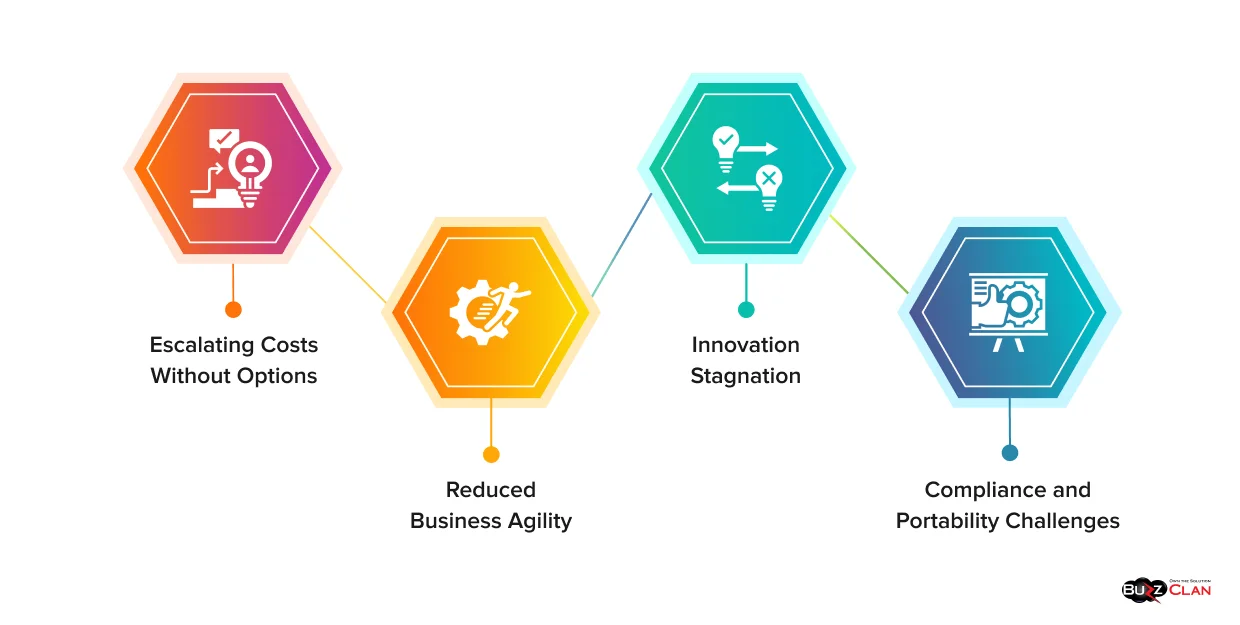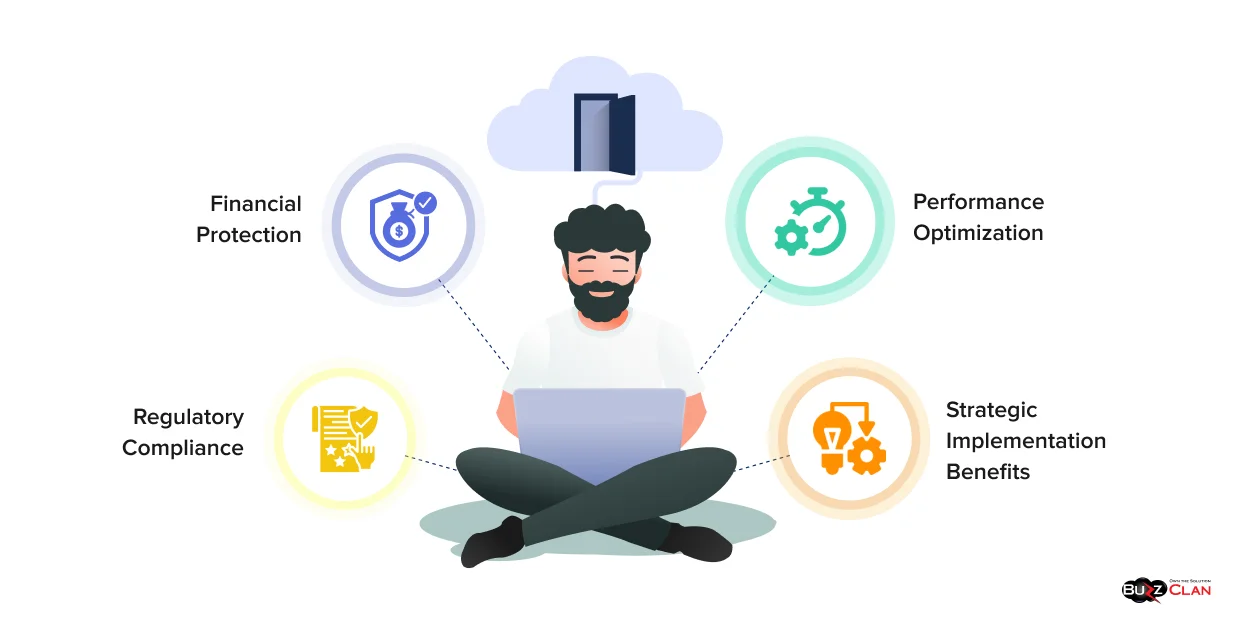Vendor Lock-in Is Real- Here’s How to Avoid It in Your Cloud Strategy
Munish Singh
Oct 10, 2025
Enterprise cloud costs are spiraling, and vendor lock-in is often the hidden culprit. Despite 89% of organizations adopting multi-cloud strategies, many remain trapped in inflexible arrangements that drive up costs and limit agility. Recent data shows that 42% of companies are considering moving workloads back on-premises to escape vendor dependencies.
The financial stakes are immense, too. Basecamp projected $7 million in savings over five years by avoiding cloud lock-in, while the UK Cabinet Office estimated that overreliance on a single provider could cost public bodies £894 million. These aren’t outliers; they represent a growing recognition that vendor lock-in transforms from a convenience into a strategic liability.
In this blog, we’ll explore what vendor lock-in really means, why it poses serious business risks, and how multi-cloud strategies with robust exit planning can protect your organization’s future. You’ll also discover how strategic planning and the right partnerships can turn vendor relationships from constraints into competitive advantages.
What Is Vendor Lock-in?
Vendor lock-in occurs when switching to a different technology provider becomes so expensive, complex, or disruptive that organizations remain trapped with their current vendor, even when better alternatives exist.
Think beyond simple inconvenience. Vendor lock-in (a.k.a supplier lock-in) represents a strategic business trap where dependency on proprietary services, APIs, data formats, or specialized infrastructure makes migration prohibitively expensive. Organizations often discover they’re locked in only when vendors raise prices, change terms, or fail to deliver expected service levels. By then, escape routes have become financially devastating.
Real-World Lock-in Example
Consider a healthcare organization that built its patient management system using AWS-specific services over three years, integrating deeply with proprietary APIs and custom workflows.
When AWS increased pricing by 40% and the organization sought alternatives, they discovered migration would require:
- Complete application rewrite using different cloud APIs and architectures.
- Data migration costs would exceed $2 million for 50TB of patient records, thanks to data gravity.
- 18-month timeline for testing, compliance certification, and deployment.
- Staff retraining on entirely new technology stacks.
The switching costs totaled $8.5 million, making it financially impossible to leave AWS, despite better pricing from competitors. This scenario illustrates how organizations can become prisoners of their own technology choices, trapped by investments they thought were building competitive advantage.
Why Vendor Lock-in Is a Problem

Vendor lock-in creates cascading business problems that extend far beyond technology concerns. It fundamentally undermines strategic flexibility and financial control. When organizations become dependent on a single vendor’s ecosystem, they surrender their ability to adapt quickly to market changes, negotiate from positions of strength, or optimize costs through competition.
Here are a few problems of vendor lock-in:
Escalating Costs Without Options
The biggest immediate problem is financial. When you’re locked in, vendors can raise prices knowing you can’t leave easily. IBM’s 80% software price increase over the past decade shows exactly how this works. Companies often find that their cloud strategy isn’t delivering the expected ROI, as vendors gradually increase prices after establishing a dependency.
Reduced Business Agility
Lock-in severely limits your ability to respond to changing business needs. When new technologies emerge or your business model shifts, you’re stuck working within your current vendor’s limitations rather than choosing the best solutions available.
This agility problem becomes particularly acute in rapidly evolving sectors like healthcare, where regulatory changes, new treatment protocols, or integration requirements may demand different technological approaches than what their current vendor supports.
Innovation Stagnation
Vendors with captive customer bases have reduced incentives to innovate aggressively or respond to customer feedback. Why invest heavily in new features when customers cannot easily leave? This dynamic creates a competitive disadvantage for locked-in organizations that cannot access best-in-class solutions emerging from other providers.
Compliance and Portability Challenges
Modern businesses operate across multiple jurisdictions with varying regulatory requirements. Vendor lock-in can create compliance risks when organizations cannot quickly adapt their technology stack to meet new regulatory demands. For healthcare organizations, this might mean an inability to comply with new patient data protection requirements if their current vendor doesn’t support necessary security features.
The portability problem extends beyond data, including institutional knowledge, trained staff, and operational procedures that become vendor-specific. Organizations essentially become bound by their own expertise, unable to leverage their investments in new environments.
How Multi-Cloud Strategy Reduces Lock-in
A well-planned multi-cloud strategy, which runs workloads across two or more providers, cuts the economic ties of supplier lock-in. Roughly 86% of enterprises already operate in multi-cloud environments, precisely to avoid vendor lock-in and hold pricing power when contracts renew.
Workload Distribution and Risk Mitigation
By spreading applications and data across AWS, Azure, Google Cloud, and other providers, organizations eliminate single points of failure. When one provider experiences outages or service issues, operations continue seamlessly on alternative platforms. This approach also prevents any single vendor from gaining excessive leverage over pricing or service terms.
Competitive Pricing Leverage
Negotiating Power increases significantly in multi-cloud scenarios. When vendors know that customers have viable alternatives already running in production, pricing discussions become more competitive. Organizations can leverage actual migration capabilities rather than theoretical threats, creating genuine competition for their business. This dynamic often results in better pricing, enhanced service levels, and more favorable contract terms across all provider relationships.
Best-of-Breed Service Selection
Rather than accepting one provider’s complete stack, enterprises can choose optimal services for specific use cases. Netflix combines AWS for content delivery with Google Cloud for machine learning analytics, ensuring they always have access to leading-edge capabilities, regardless of which vendor develops them first.
Reduced Data Migration Complexity
Multi-cloud architectures force organizations to adopt portable data formats and standardized APIs from the start. This investment in portability makes future migrations exponentially easier and less expensive than single-cloud deployments that become deeply integrated with proprietary services.
Enhanced Compliance and Governance
Different regions and industries often require specific compliance capabilities. Multi-cloud enables organizations to place workloads in jurisdictions with appropriate regulatory frameworks while maintaining unified cloud governance across their entire infrastructure.
Why Do Organizations Need a Cloud Exit Strategy?
A cloud exit strategy is a comprehensive plan that outlines how an organization can migrate away from its current cloud provider with minimal disruption, cost, or data loss. While it might seem counterintuitive to plan an exit before fully committing to a provider, smart enterprises treat cloud exit strategies as essential insurance policies against future vendor dependency.
The Reality of Cloud Provider Changes
Cloud providers regularly modify their pricing structures, service offerings, and terms of service. Oracle’s acquisition of various cloud companies resulted in dramatic price increases for existing customers, forcing many organizations into expensive migrations they hadn’t planned. Similarly, when Google Cloud announced the shutdown of certain services with short notice periods, companies scrambling without exit plans faced potential service disruptions and emergency migration costs.
The unpredictable nature of the cloud industry makes exit planning particularly crucial. Mergers, acquisitions, regulatory changes, or shifts in business focus can dramatically alter a provider’s service landscape. Organizations without clear exit strategies become hostages to these external changes.
Benefits of Planning a Cloud Exit Strategy

- Financial Protection: Exit strategies prevent organizations from being trapped by sudden price increases or unfavorable contract modifications. Companies with well-documented migration procedures can credibly threaten to leave during contract negotiations, maintaining leverage over pricing and terms.
- Regulatory Compliance: Industries like healthcare and financial services face evolving compliance requirements. A cloud exit strategy ensures organizations can quickly move to providers that meet new regulatory standards without compromising operations or facing penalties.
- Performance Optimization: Technology evolves rapidly, and today’s optimal provider may not remain competitive tomorrow. Exit strategies enable organizations to capitalize on emerging technologies and better-performing alternatives without being constrained by switching costs.
- Strategic Implementation Benefits: Organizations with documented exit strategies report several advantages beyond just risk mitigation. They negotiate better initial contracts because providers recognize the credible threat of departure. These companies also maintain cleaner, more portable architectures since they design systems with migration in mind from the beginning.
Success requires treating exit planning as an ongoing process rather than a one-time exercise. As applications evolve and new services deploy, exit documentation must stay current to remain viable when needed.
Is your business prepared for the unexpected? Let’s build your cloud exit strategy.
Contact us to develop comprehensive exit planning that protects your organization’s future flexibility.
How Does BuzzClan Help Mitigate Vendor Lock-In?
BuzzClan’s approach to mitigating vendor lock-in centers on building cloud-agnostic architectures and implementing proven multi-cloud strategies that preserve enterprise flexibility while delivering immediate business value.
Proven Multi-Cloud Implementations
Our track record demonstrates measurable results in reducing vendor dependency. For a leading financial services client, BuzzClan implemented a multi-cloud DevOps transformation that achieved 99.9% uptime while reducing deployment times by 30%. The solution utilizes cloud-agnostic CI/CD pipelines and automated ephemeral environments that operate identically across multiple providers.
Another financial services engagement delivered 50% faster time-to-market through standardized deployment processes that eliminated vendor-specific dependencies. Click here to read the full case study. These implementations showcase how proper architecture prevents lock-in while improving operational efficiency.
Comprehensive Cloud Strategy Development
BuzzClan’s methodology addresses the full spectrum of vendor lock-in risks through strategic planning, technical implementation, and ongoing optimization. We help organizations develop robust cloud migration strategies that prioritize portability, implement effective cloud governance frameworks, and establish monitoring systems that work across multiple cloud environments.
Strategic Cloud Architecture Design
BuzzClan designs cloud solutions using portable technologies and open standards from the ground up. Our implementations prioritize Kubernetes orchestration, containerized applications, and infrastructure-as-code approaches that work consistently across AWS, Azure, Google Cloud, and hybrid environments. This foundation ensures clients can migrate workloads without architectural rewrites.
Ready to build a vendor-independent cloud strategy that protects your future flexibility?
Explore our cloud computing solutions and discover how we help enterprises maintain control over their technology destiny.
Conclusion
Vendor lock-in transforms cloud technology from a competitive advantage into a strategic liability. The solution isn’t avoiding cloud adoption—it’s adopting it strategically.
The future belongs to organizations that maintain control over their technology destiny. In a world where cloud providers can change terms overnight, vendor independence is not only smart planning but also crucial for business survival.
Don’t let vendor dependency constrain your growth.
Contact our cloud experts to build a strategy that delivers innovation without sacrificing flexibility.
FAQs

Get In Touch